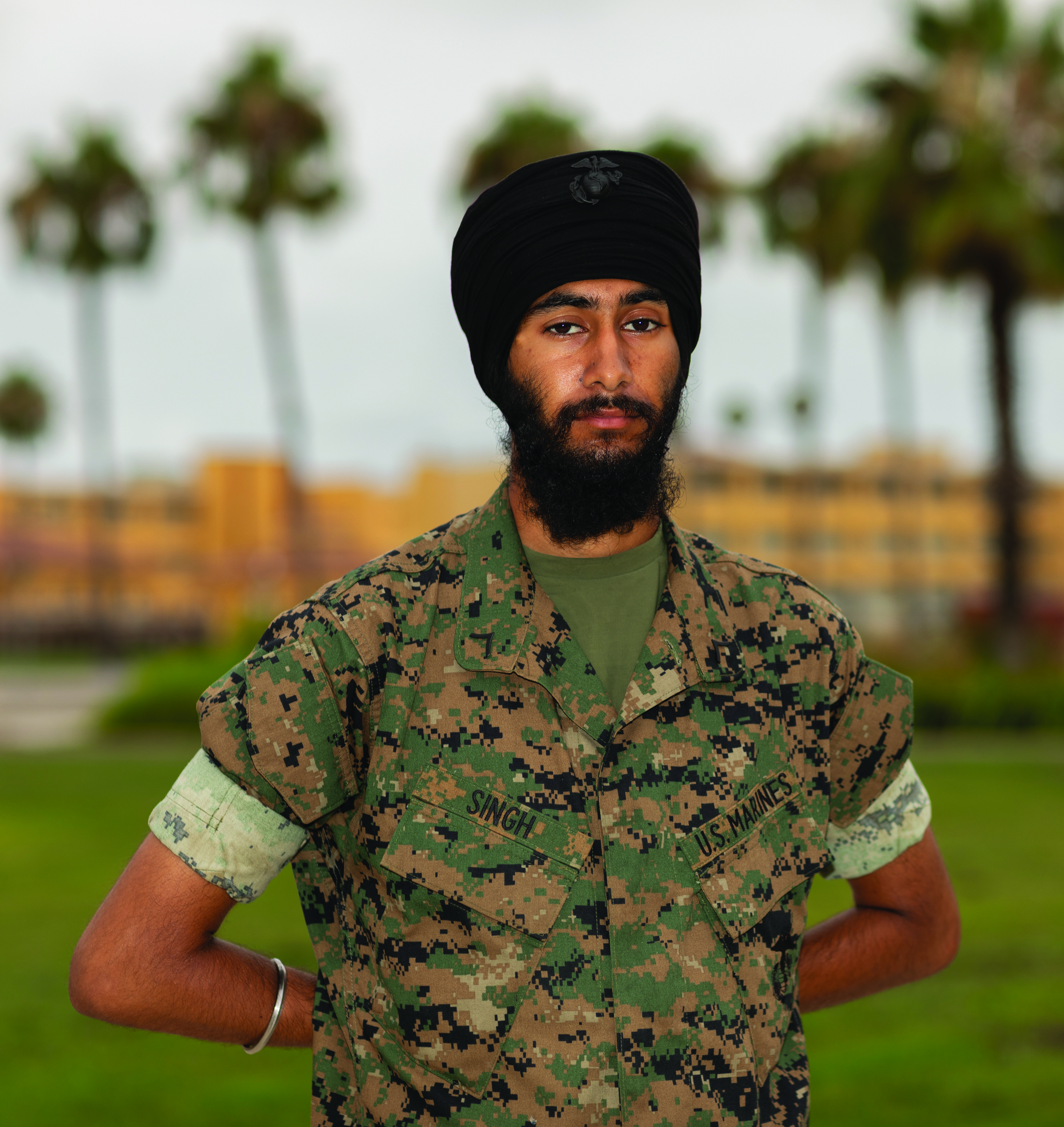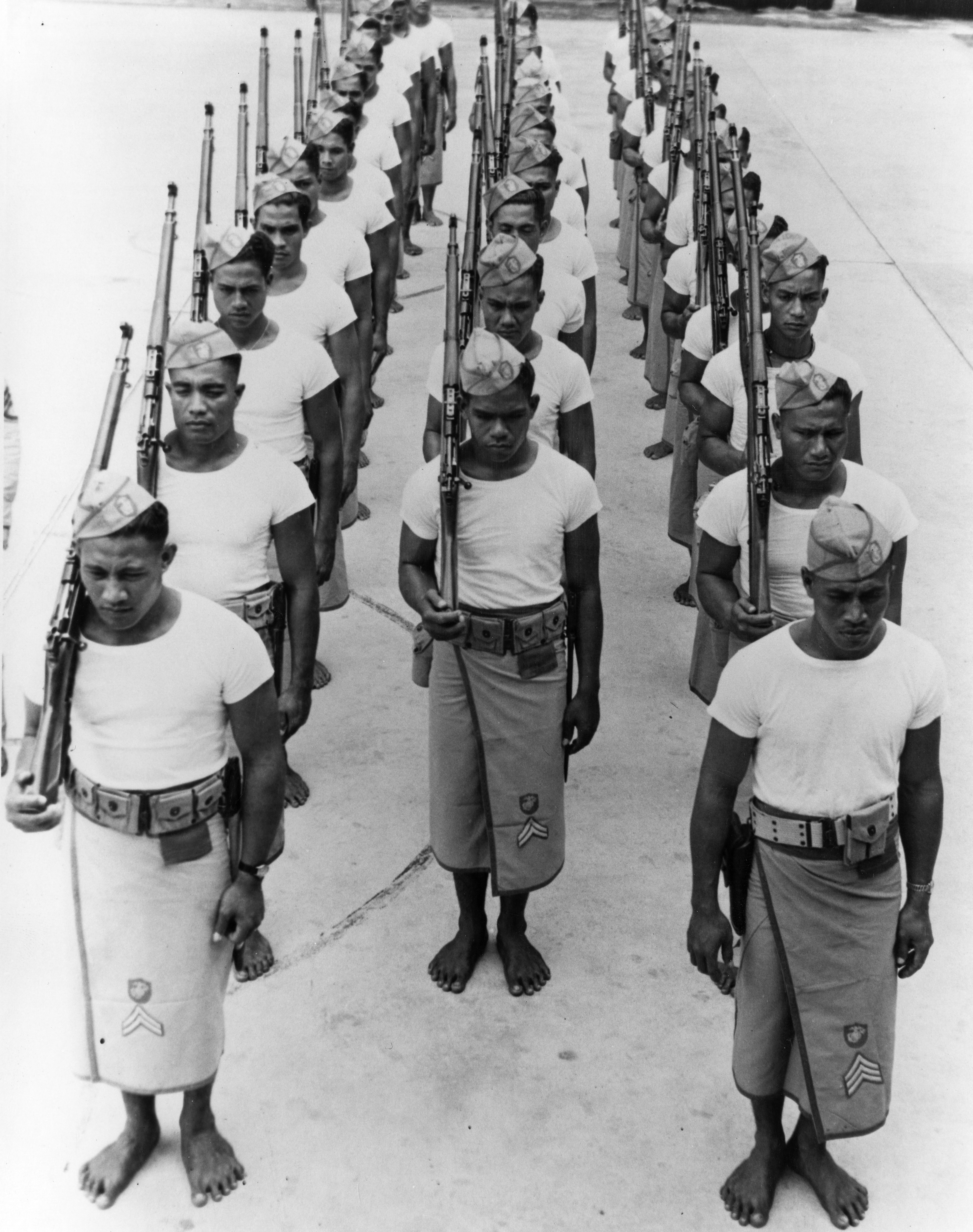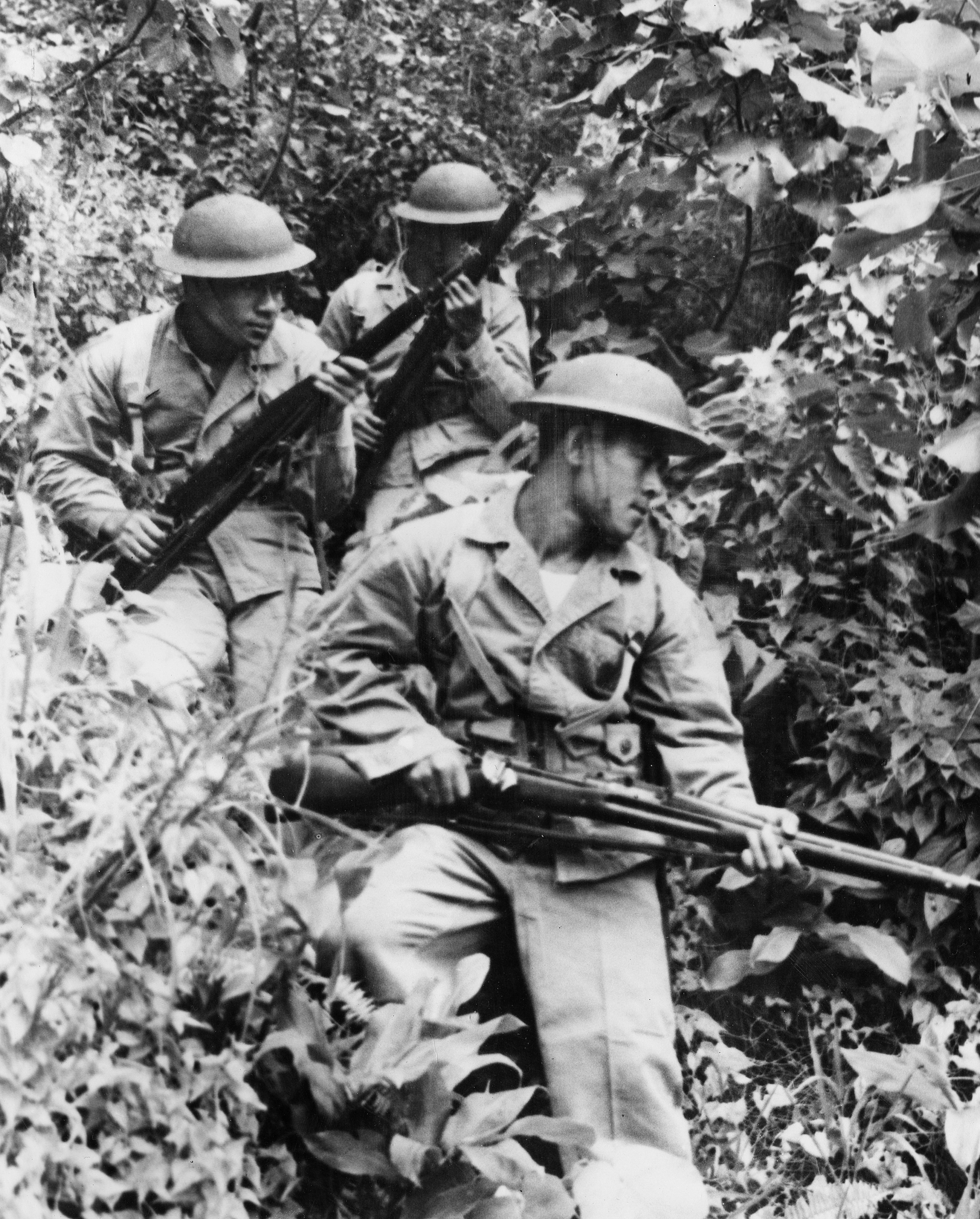Chapter 25
“Barefoot Marines”
American Samoans in World War II
By Owen Linlithgow Conner, Chief Curator
Featured artifacts: Lava-Lava (1997.66.1); and Garrison Cap (1997.66.2)
In 250 years of U.S. Marine Corps history, the distinctive style and appearance of Marine uniforms has always played part in the Service’s unique sense of identity and pride. However, from the very beginning, the Marines often designed their uniforms based on practicality and a limited budget. The original green uniforms worn by the Continental Marines, for example, were not inspired by the green uniforms of European armies’ expert riflemen, but rather by the abundance of green fabric already found in Philadelphia warehouses.[1] As the Corps evolved and expanded, its uniforms followed more traditional influences. These designs were inspired by dominant powers of their respective eras, such as England, France, and Germany.
In the early twentieth century, Marine uniforms evolved to be more practical, but they often retained elements of earlier eras, particularly with dress or full-dress attire. This was generally based on an appreciation of their history but was equally a preference for conservative appearance and uniform simplicity. In the modern era, however, the Marine Corps has evolved to meet changing demographics. The role of female Marines serving equally and side by side with male Marines has introduced new styles to their dress and service uniforms.[2] In the name of religious and cultural accommodation, the Marine Corps has also authorized distinctive headgear and grooming standards for Sikh American Marines.[3]

PFC Jaskirat Singh is the first Sikh Marine allowed to wear his articles of faith after graduating from recruit training on 11 August 2023.
Official U.S. Marine Corps photo by Jesse Lora.
This acceptance of new styles and cultural adaptations may seem like a surprise and an indication of the pressures of modern times, but historically this is not the case. In the past, the Marine Corps previously set precedence with similar flexibility in uniform design. This is best illustrated during World War II, when in the name of functionality, practicality, and respect for distinct Polynesian culture, unique Marine Corps uniforms were created and worn by American Samoan Marines. These uniforms were unlike any seen before or since.

The uniform worn by Samoan Marines during World War II is one of the most unique and rare uniforms in Marine Corps history.
Photo by Jose Esquilin, Marine Corps University Press.
History of the Barefoot Marines
American Samoa was first established as a U.S. territory in 1900. It is comprised of several islands and coral atolls, the largest being the island of Tutuila.[4] Due to its strategic value and deep-water harbor at Pago Pago, the islands were administered by the U.S. Navy. From the very beginning, native Samoans played a role in its defense. The first Samoan naval forces were organized to serve as police and guards for the island. Known as the Fita-Fita Guard, service within the unit became a source of pride to the islanders. Positions were limited, and members were officially recognized as members of the U.S. Naval Reserve.[5] They were also uniquely dressed. The navy uniform consisted of just four pieces. A bright red muslin turban-style head wrap was accentuated by a distinctive waist sash of the same color. In lieu of trousers, the men wore a traditional lava-lava, or cotton sarong in Navy blue serge. The uniform was completed with the wearing of a plain white undershirt and no shoes.[6]
Prior to the Japanese attack on Pearl Harbor, Hawaii, on 7 December 1941, the U.S. Navy had already recognized the importance of American Samoa in the defense of the Pacific theater and began to reinforce its position there. The first reinforcements to arrive were Marines from the 7th Defense Battalion. Even when paired with the existing Fita-Fita naval reserves, the Marines realized that they would need additional forces to defend the islands. As a result, the U.S. government authorized the creation of a new battalion of 500 troops. Designated the 1st Samoan Marine Battalion, the unit was activated on 1 July 1941 and placed under the command of the 7th Defense Battalion.[7]

American Samoans take the oath of enlistment in the Marine Corps, ca. 1941.
Nusbaum collection, Marine Corps History Division.

Marines of the 1st Samoan Marine Battalion stand ready for inspection in their distinctive dress uniforms.
Nusbaum collection, Marine Corps History Division.
The Samoan Marines were based in the eastern and western districts of the island’s defense. The battalion’s smaller subunits consisted of a rifle company and three support platoons. These Marines operated 6-inch naval guns and heavy machine guns. Interestingly, the Samoan Marines were provided with overseas pay, even though were defending their home islands.[8] They also formed a unit softball team that regularly defeated their fellow American servicemen and became the best on the island.[9]
After the Japanese attack on Pearl Harbor and simultaneous assault across the Pacific, tensions on the Samoan Islands ran high. On 11 January 1942, a Japanese submarine shelled the main island of Tutuila. Targeting the primary U.S. naval station there, damage was minimal, but the submarine’s shell fire managed to strike the Navy dispensary and ironically the home and business of the island’s sole Japanese citizen.[10]
Thankfully, this attack would be the only instance of an enemy incursion during the war. By the summer of 1942, Allied victories in the Battles of the Coral Sea and Midway thwarted the Japanese advance in the Pacific. As a result, the Samoan islands began to take on a supporting role in the war effort. America Samoa served as a base for the deployment of U.S. forces rather than as a key defensive position. The 1st Samoan Marine Battalion remained active until January 1944, when its companies were slowly disbanded over the course of the year and its Marines were reassigned to Marine Barracks, Naval Station Tutuila, Samoa Islands. While the experience of the 1st Samoan Marine Battalion was short-lived, these fascinating Marines played a special part in Marine Corps uniform history—marking the first time that the wearing of shoes was against regulations.

Barefoot Marines stand in parade formation.
Marine Corps History Division.
The Uniform of the Barefoot Marines
The official combat or service/utility uniform of the 1st Samoan Marine Battalion initially consisted of the same 1937 regulation khaki cotton summer service uniforms worn by all Marines in the early days of the war. In the field, these uniforms were paired with the M1917A1 steel helmet (similar to the helmets worn by U.S. servicemembers in World War I) and standard Marine Corps-issue load-bearing equipment such as the M1923 cartridge belt and suspender system.[11] Photographic documentation during the war also shows that some Samoan Marines chose to wear camouflaged burlap covers on their helmets, similar to the Marine Raiders and often seen in early operations on Guadalcanal and Tulagi. Despite their similarity to standard Marine Corps combat uniforms, the Samoans still did not wear boots or shoes and remained barefoot even in the field.

As the war progressed, the Samoan Marines transitioned to the same herringbone utility combat uniforms worn by all Marines.
Marine Corps History Division.

The Samoan Marine insignia is one of the rarest Marine Corps patches of World War II.
Photo by Jose Esquilin, Marine Corps University Press.
Some of the first official documentation for the supply of the distinctive Samoan Marine dress uniform items comes from the commanding officer of the 1st Samoan Marine Battalion to the U.S. Marine Corps Depot Quartermaster in Philadelphia, Pennsylvania. Dated 29 July 1941, the letter requested the procurement of official Marine Corps insignia for their uniforms. This would consist of a red felt shield patch with a yellow embroidered eagle, globe, and anchor insignia. It was sewn on the side of the men’s red-piped khaki garrison caps and displayed on the lower half of their khaki cotton lava-lava dress. Samoan Marines who received promotions above the grade of private were also entitled to wear standard Marine Corps chevrons on their lava-lava. Marine Corps dress chevrons of scarlet and gold, ranging from private first class to sergeant, were officially acquired via this purchase order. More unusual for this uniform procurement was the commanding officer’s request for 200 yards of “scarlet cloth, approximately 42 inches wide, for use in making sashes” and the need for 1,500 yards of “scarlet tape” to be used as the piping for the Marines’ lava-lava. The uniform was completed with the request for a supply of white cotton undershirts, the same as “regular Marine Corps issue,”[12] And, once again, no boots or field shoes were required.
While the Marines of the 1st Samoan Marine Battalion were never called to defend their home island from a Japanese invasion, their unique place in the history of the Marine Corps is assured. Their patriotism and esprit de corps remain unquestionable. The story of the “Barefoot Marines” also serves as an important reminder of the Marine Corps’ ability to improvise and adapt to new circumstances and cultures while at the same time retaining the pride and identity of all U.S. Marines. This investment in the American Samoan people and their culture is repaid today in the disproportionate service of their people in the U.S. armed forces. Based on their population, America Samoa enlists more servicemembers per capita than any other U.S. territory or state.[13]
Endnotes
[1] LtCol Charles H. Cureton, “Parade Blue, Battle Green,” in The Marines, ed. BGen Edwin H. Simmons, USMC (Ret), and J. Robert Moskin (Quantico, VA: Marine Corps Heritage Foundation, 1998), 131.
[2] Kaitlin Kelly, “New Dress Blues for Females Provide Unified Look for Marines,” Leatherneck 102, no. 2 (February 2019): 33–34.
[3] Philip Athey, “A Sikh Marine Is Now Allowed to Wear a Turban in Uniform,” Marine Corps Times, 5 October 2021.
[4] “American Samoa,” U.S. Department of the Interior, accessed 7 May 2024.
[5] Col Robert H. Rankin, Uniforms of the Sea Services (Annapolis, MD: U.S. Naval Institute, 1962), 211.
[6] 1stSgt Nelson Huron, Notes from United States Naval Station, Tutuila, Samoa, 28 February 1925 (Archives Branch, Marine Corps History Division, Quantico, VA).
[7] Timothy Heck, B. A. Friedman, and Walker D. Mills, eds., On Contested Shores: The Evolving Role of Amphibious Operations in the History of Warfare, vol. 2 (Quantico, VA: Marine Corps University Press, 2024), 276–300, https://doi.org/10.56686/9798986259581.
[8] William Block, “Barefoot Marines,” Trading Post (American Society of Military Insignia Collectors) 53, no. 3 (July–September 1994): 2.
[9] LtCol Kenneth S. Giles, USAF, donor correspondence, National Museum of the Marine Corps, 22 December 2004.
[10] “American Samoa,” Nevington War Museum, accessed 7 May 2024.
[11] Alec S. Tulkoff, Grunt Gear: USMC Combat Infantry Equipment of World War II (Mountain View, CA: R. James Bender, 2003), 142.
[12] Original primary source documents from Marine Corps History Division, Quantico, VA.
[13] Tracey Long, “American Samoans’ Strong Military Tradition,” KIRO 7 News (Seattle), 27 May 2021.